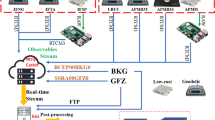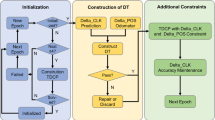Abstract
This work describes the barometric altimetry as virtual constellation applied to the Chinese Area Positioning System (CAPS), which uses the transponders of communication satellites to transfer navigation messages to users. Barometric altimetry depends on the relationship of air pressure varying with altitude in the Earth’s atmosphere. Once the air pressure at a location is measured the site altitude can be found. This method is able to enhance and improve the availability of three-dimensional positioning. The difficulty is that the relation between barometric pressure and altitude is variable in different areas and under various weather conditions. Hence, in order to obtain higher accuracy, we need to acquire the real-time air pressure corresponding to an altimetric region’s reference height. On the other hand, the altimetry method will be applied to satellite navigation system, but the greatest difficulty lies in how to get the real-time air pressure value at the reference height in the broad areas overlaid by satellite navigation. We propose an innovational method to solve this problem. It is to collect the real-time air pressures and temperatures of the 1860 known-altitude weather observatories over China and around via satellite communication and to carry out time extrapolation forecast uniformly. To reduce data quantity, we first partition the data and encode them and then broadcast these information via navigation message to CAPS users’ receivers. Upon the interpolations being done in receivers, the reference air pressure and temperature at the receiver’s nearby place is derived. Lastly, combing with the receiver-observed real air pressure and temperature, the site’s altitude can be determined. The work is presented in the following aspects: the calculation principle, formulae, data collection, encoding, prediction, interpolation method, navigation message transmission together with errors causes and analyses. The advantages and shortcomings of the technique are discussed at the end.
Similar content being viewed by others
References
Kaplan E D. Understanding GPS: Principles and Applications. 2nd ed. Boston: Artech House, 2005
Yuan J P, Luo J J, Yue X K, et al. Satellite Navigation Principle and Application. Beijing: China Aerospace Press, 2003
Ai G X, Shi H L, Wu H T, et al. A positioning system based satellite communication and the Chinese Area Positioning System (CAPS). Chin J Astron Astronphys, 2008, 8(6): 611–630
Ai G X, Shi H L, Wu H T, et al. The principles of the positioning system based on communication satellites. Sci China Ser G-Phys Mech Astron, 2009, 52(3): 472–488
Sheng P X, Mao J T. Atmospheric Physics (in Chinese). Beijing: Beijing University Press, 2003. 30–35
U. S. Standard Atmosphere. Washington: U.S. Government Printing Office, 1976
Wang Q, Zhang Q, Wang F L. Error sources of pressure sensor and effects on altimeter measurement. J Spacecr TT C Technol, 2002, 21(2): 91–94
Author information
Authors and Affiliations
Corresponding author
Additional information
Supported by the National Basic Research Program of China (Grant No. 2007CB815500), the National High Technology Research and Development Program (Grant No. 2004AA105030), the Pilot Project of the Knowledge Innovation Program of the Chinese Academy of Sciences (Grant No. KGCX1-21), and the National Natural Science Foundation of China (Grant No. 10453001)
Rights and permissions
About this article
Cite this article
Ai, G., Sheng, P., Du, J. et al. Barometric altimetry system as virtual constellation applied in CAPS. Sci. China Ser. G-Phys. Mech. Astron. 52, 376–383 (2009). https://doi.org/10.1007/s11433-009-0060-y
Received:
Accepted:
Published:
Issue Date:
DOI: https://doi.org/10.1007/s11433-009-0060-y




